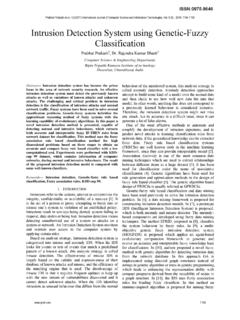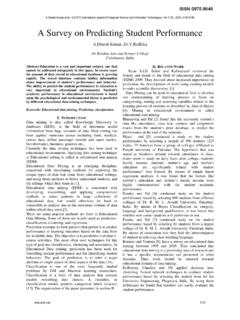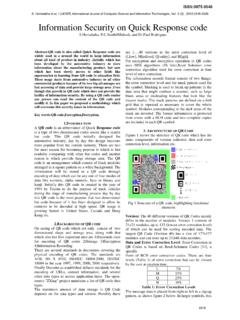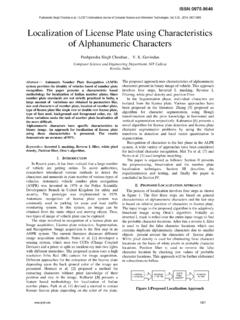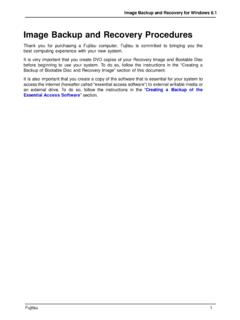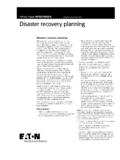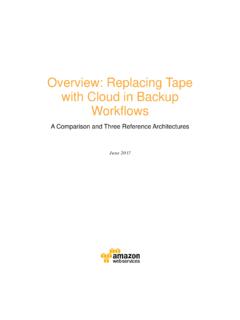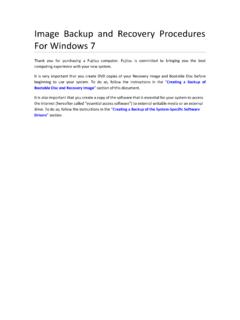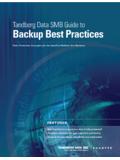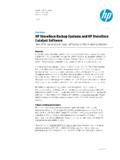Transcription of Link/Node Failure Recovery through Backup Path Lengths
1 Link/Node Failure Recovery through Backup path Lengths Ravula Prathap Kumar, Banothu Balaji, Dasari Yakobu, N Sai Bala Kishore Department of Computer Science and Engineering, Vignan University, Guntur, AndhraPradesh, India Abstract- the Internet has evolved into a platform with applications having strict demands on robustness and availability, like trading systems, online games, telephony, and video conferencing. This project develops novel mechanisms for recovering from failures in wired networks with proactive Backup path calculations. The primary scheme provides resilience for up to two link failures along a path . A network should be minimum three edge connected in order to tolerate dual link Failure . Protection graphs mechanism is required in order to handle the Link/Node Failure . When Failure occurs packets are routed over the protection graph.
2 Then the network recovers from the first Failure by tunneling the packet to the next-hop node. An extension to the basic scheme provides Recovery from single-node failures in the network. It involves an identification of the failed node in the packet path and then routing the packet to the destination along an alternate path that does not containing the failed node. An efficient approach to route packets along link- or node disjoint paths in networks with minimum lookup time is to employ colored trees (CTs). In this approach, two trees, namely red and blue, are constructed rooted at a destination such that the paths from any node to the destination on the two trees are link- or node-disjoint. The effectiveness of these techniques was evaluated by simulating the developed algorithm over Arpanet network topology. Keywords- IP fast reroute, Failure Recovery , multiple link failures, node Failure , network protection, independent trees.
3 1. INTRODUCTION The Internet has evolved into a platform with applications having strict demands on robustness and availability, like trading systems, online games, telephony, and video conferencing. For these applications, even short service disruptions caused by routing convergence can lead to intolerable performance degradations. As a response, several mechanisms have been proposed to give fast Recovery from failures at the Internet Protocol (IP) layer. In these schemes, Backup next-hops are prepared before a Failure occurs, and the discovering router handles a component Failure locally without signaling to the rest of the network. Using one of these fast-rerouting methods, the Recovery time is mainly decided by the time it takes to discover the Failure . This can typically be done in a few milliseconds, using signaling from the physical layer or a Failure detection protocol like BFD.
4 This is a significant improvement over the Recovery times achieved by a normal routing re-convergence, which typically takes several seconds. Recovery times can be reduced by aggressive timer settings, but this comes at the risk of triggering unwanted routing convergence due to, , flapping links. Often, proactive Recovery schemes are thought of as a first line of defense against component failures. They are used to maintain valid routing paths between the nodes in the network, until the routing protocol converges on a new global view of the topology. Such a strategy is particularly germane when facing transient failures, which are common in IP networks today. While single-link failures are the most common Failure type, it is also interesting to explore methods that protect against two simultaneous link failures.
5 Measurement studies indicate that about 30% of unplanned failures affect more than one link. Half of these affect links that are not connected to the same node. It is sometimes possible to identify Shared Risk Link Groups (SRLG) of links that are likely to fail simultaneously by a careful mapping of components that share the same underlying fiber infrastructure. This might, however, be a complex and difficult task since the dependencies in the underlying transport network might not be fully known and can change over time. A Recovery method that can recover from two independent and simultaneous link failures will greatly reduce the need for such a mapping. The goal of this paper is to enhance the robustness of the network to: 1) dual-link failures; and 2) single-node failures. To this end, we develop techniques that combine the positive aspects of the various single-link and node Failure Recovery techniques.
6 In the developed approach, every node is assigned up to four addresses one normal address and up to three protection addresses. The network recovers from the first Failure using IP-in-IP tunneling (RFC2003) with one of the protection addresses of the next node in the path . Packets destined to the protection address of a node are routed over a protection graph where the failed link is not present. Every protection graph is guaranteed to be two-edge-connected by construction, hence is guaranteed to tolerate another link Failure . This paper develop an elegant technique to compute the protection graphs at a node such that each link connected to the node is removed in at least one of the protection graphs, and every protection graph is two-edge-connected. The highlight of the approach is to prove that every node requires at most three protection graphs, hence three protection addresses.
7 When a tunneled packet encounters multiple link failures connected to the same next-hop node, and then conclude that the next-hop node has failed. The packet is then forwarded to the original destination from the last good node in the protection graph along a path that does not contain the failed node. Ravula Prathap Kumar et al, / (IJCSIT) International Journal of Computer Science and Information Technologies, Vol. 4 (6) , 2013, 2. RELATED WORK S. Kini, S. Ramasubramanian, A. Kvalbein, and A. Hansen [1] developed a novel mechanism for recovering from dual link failures in IP networks. The proposed technique requires three protection addresses for every node in addition to the normal address associated with every protection address of a node in a protection graph. Each link connected to the node is removed in at least one of protection graphs and every protection graph is guaranteed to be two-edge connected.
8 The network recovers from the first Failure by tunneling the packet to the next-hop node using one of the protection addresses of the next-hop node; and the packet is routed over the protection graph corresponding to that protection address. (a) Red Tree rooted at A (b) Blue Tree rooted at A Fig. Example Network with colsored trees rooted at node A S. Lee, Y. Yu, S. Nelakuditi, Zhang, and Chuah [4] proposes a novel proactive intra-domain routing approach Failure Insensitive Routing (FIR) for ensuring high service availability and reliability without changing the conventional destination-based forwarding paradigm. There are two key ideas that under the proposed approach: interface-specific forwarding and local rerouting. These ideas enable us to infer link failures based on packets flight (the interfaces they are coming from), pre-compute interface-specific forwarding tables ( alternative paths) in a distributed manner and trigger local rerouting without relying on network-wide link-state advertisements.
9 The proposed approach can effectively handle transient link failures that are most frequent in today s networks. It enhances Failure resiliency and routing stability by suppressing the advertisement of transient failures and locally rerouting packets during the suppression period. , A. F. Hansen, S. Gjessing, and O. Lysne [3] presented a new Recovery scheme called Multiple Routing Configurations (MRC). MRC is based on keeping additional routing information in the routers, and allows packet forwarding to continue on an alternative output link immediately after the detection of a Failure . The proposed scheme guarantees Recovery in all single Failure scenarios, using a single mechanism to handle both link and node failures, and without knowing the root cause of the Failure . MRC is strictly connectionless, and assumes only destination based hop-by-hop forwarding.
10 It can be implemented with only minor changes to existing solutions. In this paper present MRC, and analyze its performance with respect to scalability, Backup path Lengths , and load distribution after a Failure . , G. Iannaccone, S. Bhattacharyya, Chuah, and C. Diot [9], analyze IS-IS routing updates from Sprint s IP network to characterize failures that affect IP connectivity. Failures are first classified based on probable causes such as maintenance activities, router-related and optical layer problems. Key temporal and spatial characteristics of each class are analyzed and, when appropriate, parameterized using well-known distributions. The results indicate that 20% of all failures are due to planned maintenance activities. The classification of failures according to different causes reveals the nature and extent of failures in today s IP backbones.


